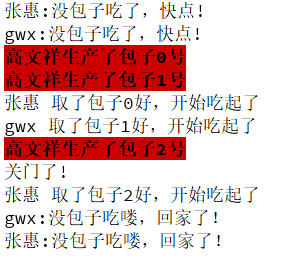19、Python之队列
一、队列的基本操作
队列其实是一种数据结构,或者更本质的说队列其实就是对基本数据结构的封装,我们也可以封装自己的数据结构。队列做大的特点是先进先出FIFO(first in first out),下面我们就看看python中队列的基本操作。
队列的基本操作如下:

1 import queue 2 3 # queue_01 = queue.Queue() #申明一个很大的队列 4 queue_01 = queue.Queue(2) #申明一个长度为3的队列 5 queue_01.put(1) #往队列中扔了一个数据 6 queue_01.put(2)#又往队列中扔了一个数据 7 queue_01.full() #判断队列是否满了 8 # queue_01.put(3)#又往队列中扔了一个数据,如果队列满 则阻塞 9 # queue_01.put(1,block=True)#如果队列满了,不阻塞 10 # queue_01.put(1,timeout=2)#设置队列阻塞时间为1s 11 queue_01.get()#从队列中取了一个数据 12 queue_01.empty() #判断队列是否为空 13 queue_01.get() #又从队列中取了一个数据 14 # queue_01.get(block=True) #又从队列中取了一个元素,如果没有就阻塞 15 # queue_01.get(block=False)#再从队列中取出一个数据,且不要阻塞,直接抛出异常 16 #queue_01.get(timeout=1)#又从队列中取了一个元素,超时时间为1s 17 18 #以下为特殊的队列 19 q = queue.LifoQueue() #先进后出 --栈 20 q2 = queue.PriorityQueue()#按照优先级取的队列 21 q2.put((2,"hello")) 22 q2.put((1,"python")) 23 print(q2.get(),q2.get())
二、实例演示,生产者消费者模式
实例代码如下:

1 import time,threading,queue 2 3 MAX_SIZE = 2 4 CUR_SIZE = 0 5 q = queue.Queue() 6 7 def producer(name): 8 global MAX_SIZE,CUR_SIZE 9 while True: 10 time.sleep(0.5) 11 q.put(CUR_SIZE) 12 print("\033[41;1m%s生产了包子%s号\033[0m" % (name,CUR_SIZE)) 13 CUR_SIZE = CUR_SIZE + 1 14 if CUR_SIZE > MAX_SIZE: 15 print("关门了!") 16 break 17 18 def consumer(name): 19 global MAX_SIZE,CUR_SIZE 20 while True: 21 if q.qsize() <= 0 and CUR_SIZE<= MAX_SIZE: 22 print("%s:没包子吃了,快点!" % name) 23 time.sleep(1) 24 elif CUR_SIZE>MAX_SIZE and q.qsize() <= 0: 25 print("%s:没包子吃喽,回家了!" % name) 26 break 27 else: 28 data = q.get() 29 print("%s 取了包子%s好,开始吃起了" % (name, data)) 30 time.sleep(3) 31 32 33 p = threading.Thread(target=producer,args=("高文祥",)) 34 c = threading.Thread(target=consumer,args=("张惠",)) 35 c_1 = threading.Thread(target=consumer,args=("gwx",)) 36 p.start() 37 c.start() 38 c_1.start()
执行结果








